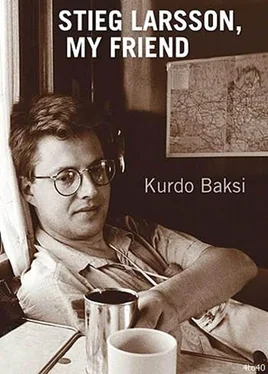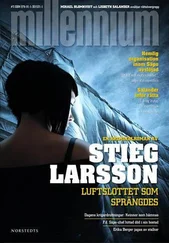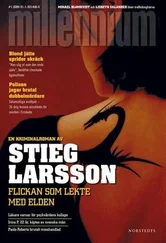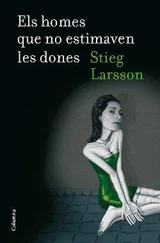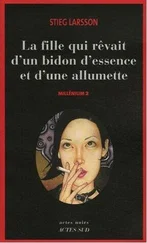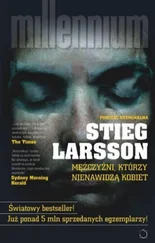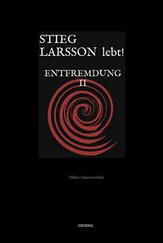I am surprised to note that he seems to have abandoned his classical “neutral” hairstyle. His hair has been cut shorter than usual. And he has acquired sideburns. The new haircut suits him. Makes him look younger. Which is more than one can say for his baggy white T-shirt. Presumably it is a present given to him as a souvenir of a lecture he delivered to some idealistic organization or other somewhere in Sweden. And his jumper has a big red stain.
Stieg is in an exceptionally good mood and waves a greeting to several people who pass by. Standing on his right is a bearded man by the name of Anders, known to everybody as Anders the Trotskyist. He has a baby in his arms. I know Anders. He is one of the organizers of this multicultural evening.
I’m standing in the doorway to the terrace when I catch sight of Stieg. Just as he takes out his pack of cigarettes and a lighter I tap him on the shoulder. He seems pleased to see me.
“This is a fun evening,” he says. “Did you know that Anders and I have known each other ever since the Vietnam demonstrations?”
I shake my head, but am not especially surprised. He orders a glass of red wine and stands there looking at the lovely little baby.
“Here we have a future warrior,” he says.
“You always look so young, Stieg,” says Anders.
The woman crime novelist is also here this evening. Stieg turns round and catches sight of her. Her first book was published a month or two previously. Even I know how much Stieg helped her to produce her final text.
Her face lights up the moment she sees him.
Mourning involves being haunted by images that take possession of you when you least expect it. It is often impossible to understand why you remember things in such detail, almost as if you were in the same place at the time they happened. You see everything so clearly, inhale the smells and hear the voices.
How you manage to fit together these fragments of memory is probably the basis for mourning. It’s a healing process. Why do I recall that evening at the theatre in Söder in such minute detail? I don’t know.
Perhaps because I bumped into that woman crime novelist only the other day. I didn’t like the fact that her body language often showed that she thought she was a better writer than Stieg. But I no longer hold that against her. After his death she wrote in her blog about how much he had meant to her. She even explained how he had gone through her manuscripts chapter by chapter, sentence by sentence, and helped her.
It was round about the time of that multicultural evening at Södra Teatern that I made a crucial decision. I had grown thoroughly sick and tired of everything associated with producing magazines. I had devoted all my energy to doing just that for seventeen long years. Now I had run out of energy, and I made up my mind to close down my beloved Svartvitt .
I had plans to continue my cooperation with Expo , but to be honest I was not at all sure how that would work out. My health had deteriorated steadily during the previous year, and it sometimes felt as if I had spent more time in hospital than in my office.
My doctors said I was displaying all the symptoms of burnout. Nobody can explain exactly what that term means. In my case it was a bit more straightforward than usual: I had absolutely no private life whatsoever.
When I told Stieg about my decision, he was sorry to hear it at first. He tried to talk me out of it, but gave up when he realized that I simply didn’t have the strength any more. In a way I suppose we both felt that the areas we had been covering in Svartvitt had started to feature in the mainstream media. But we were in complete agreement about continuing our cooperation within Expo . I said that my hope was to work on Expo as publisher and as a polemical journalist.
“We are not twenty-year-olds any more,” I said. “Both you and I must start thinking about our health.”
He nodded, but that was a subject in which he had no interest at all. Unlike me he was alert and always busy with several projects at the same time. The fact is that apart from my closing down Black and White , 2003 was a comparatively quiet year. There were no real threats, no headline-grabbing manoeuvres aimed at us, no complicated books to publish, nothing of that kind.
Naturally, we ought to have realized that it was the calm before the storm.
The following year, 2004, things happened in rapid succession. It started positively for Stieg. He was on the way to enjoying the fruits of all those sleepless nights and hard work. In the space of four months he put the finishing touches to five books, more books than he had produced during the previous forty-nine years of his life. An astonishing achievement.
As early as 22 January Debatten om hedersmord appeared. In April Stieg signed the contract with Norstedts for the publication of the three books that would become the Millennium trilogy. The very next month he worked on two central chapters of Sverigedemokraterna från insidan . He gave a lot of talks to schools and also travelled to Brussels for a conference. A paper in connection with an exhibition in Malmö took up much of his energy in the autumn. The fact is that our last conversation was about that paper, which I reckoned he should have delegated to somebody else.
In addition, it seemed that his successes were making him more extrovert than he had ever been before. He took on more and more, and went out to meet people more regularly. He became a familiar face at Café Fix, Café Anna, Café Copacabana, Café Mellqvist and Il Caffè. Although he had always felt more at home in small groups, he started to move in bigger circles and became one of the in-crowd. He was a frequent guest at the socalled multicultural events on the terrace at Södra Teatern, and stayed on until surprisingly late.
Needless to say, a lot of people continued to ask for his help and advice. A teacher in Sollentuna wanted to launch a new curriculum subject, “Tolerance and Respect”. Students asked him to read and comment on their essays about neo-Nazism or racism. Social workers responding to attacks on women needed help in various ways. And another would-be crime novelist required assistance with a manuscript.
I frequently asked myself what was going on. What had happened to Stieg’s non-stop work into the early hours? The new Stieg was barely recognizable. He had always used to slip away at the earliest opportunity in order to glue himself to his computer in peace and quiet.
I suppose it was because he had received the message he wanted to hear most of all just then. He had received confirmation that all those exhausting hours spent at the computer with his enormously long novels had been worthwhile. He had not misjudged the quality of his work. It really was good. Perhaps around this time he even began to think that his books were more than just good. Perhaps they were very special indeed.
This was probably the first time in his adult life when he could relax and felt that he could allow himself some late nights of pleasure. He could take time off.
I hope that was in fact the case. I really do think it was.
Sometimes I find myself smiling at the probability that the baggy T-shirts I so disliked were a part of this process. By shedding his jacket and tie perhaps he was building up his image as a writer. A sort of circle had closed. The slipshod working-class lad had progressed to reserved austerity and had now returned to being slipshod.
What finally convinced me that he had changed was when he suddenly started agreeing to be interviewed, and to think giving lectures was boring. To my great delight, he agreed to take part on 24 July in a live chat show on Swedish television. The last time he had appeared on live T.V. had been 24 April, 1991.
Читать дальше
